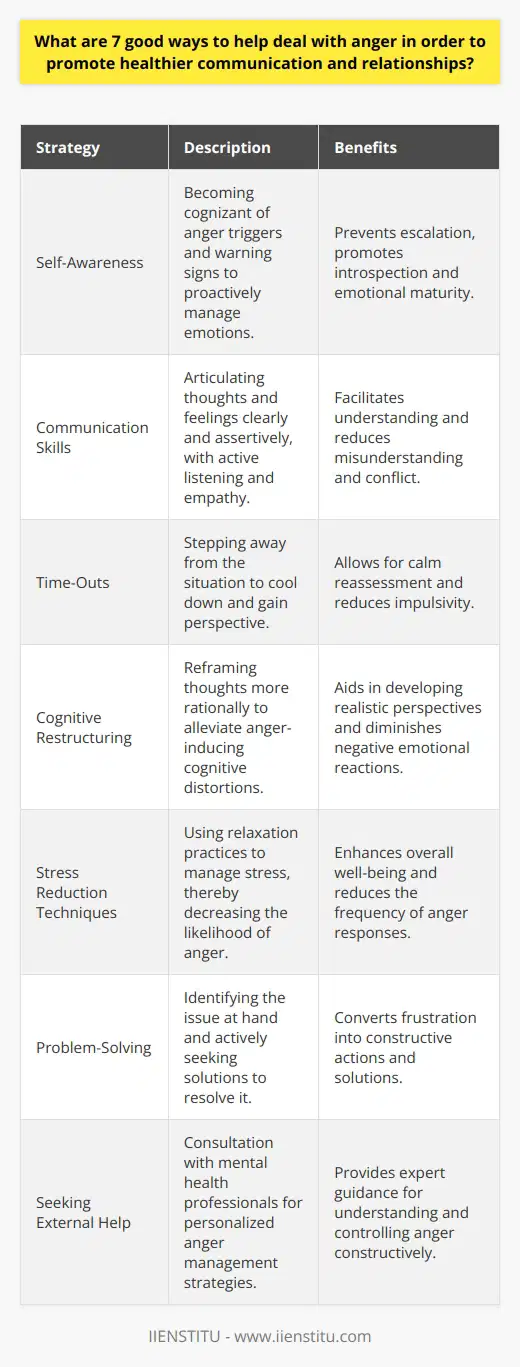
Feeling anger is something we've all experienced at one point or another. I remember a time when I was stuck in traffic, late for an important meeting. My frustration boiled over as each light turned red just before I could pass. It wasn't just about the traffic—it was about feeling blocked from reaching something significant. Anger, in that moment, was a powerful force.
Understanding Anger: Triggers, Expressions, and Consequences
Introduction
Anger is a natural emotion, and it's as human as breathing. Yet, it's often misunderstood and mishandled. We've all been there—whether it's that simmering irritation when things don't go our way, or the sudden flare-up when we feel wronged. But have you ever wondered what exactly triggers this intense emotion? Or how best to express it without causing harm to ourselves or others? Let's dive deep into the world of anger, exploring its roots, the many faces it wears, and the long-term effects it can have on our lives.
Introduction
Types of Transgressions that Trigger Anger
Ways to Express Anger
Consequences of Prolonged Anger
Conclusion
Types of Transgressions that Trigger Anger
Think back to a time when you felt truly angry. What sparked that feeling? Generally, anger arises from perceived transgressions, and these can be categorized into three main areas:
1- Blocked Goals
2- Violation of Personal Rules
3- Threats to Self-Esteem
Blocked or Thwarted Goals
When we're thwarted in achieving something important to us, it's natural to feel anger. Let me tell you about my friend Alex. He spent months preparing for a marathon, training tirelessly every morning. But on the day of the race, he woke up with a fever. Unable to participate, he felt a surge of anger—not at anyone in particular, but at the situation. His goal was blocked, leading to frustration.
In the first instance, a person may become angry if they are blocked or thwarted in some way from achieving an important goal. This could be anything from not getting a promotion at work to not being able to complete a task in the expected time frame.
In the second instance, a person may become angry if they feel that critical personal rules have been violated by another person or themselves. This could be anything from someone not returning a greeting to someone not following through on a promise.
Finally, in the third instance, a person may become angry if their self-esteem is threatened. This could be anything from being insulted or belittled by another person to feeling like one has failed to live up to their expectations.
Similarly, consider a team working hard to optimize a project, only to face unexpected setbacks. Just as companies strive to optimize supply chain management process tips to achieve efficiency, individuals aim to streamline their paths to success. When obstacles arise, anger can surface.
Violation of Personal Rules
We've all got those unwritten rules, right? Like expecting honesty in relationships. When someone breaks these rules, it feels like a personal affront. I recall when a colleague took credit for my ideas during a meeting. It wasn't just about the idea—it was about respect and integrity. Breaking these personal codes can trigger intense feelings of anger and betrayal.
Threats to Self-Esteem
Self-esteem is like a delicate flower; it needs nurturing. When someone belittles us, whether intentionally or not, it can feel like an attack. I once received harsh criticism from a supervisor in front of my peers. It wasn't just embarrassing—it felt like my competence was under fire, and it stirred up strong feelings of anger.
Ways to Express Anger
So, when anger bubbles up, how do we let it out? There are several ways, and not all are created equal.
1. Verbal and Physical Aggression
This is the "classic" expression of anger—yelling, swearing, or even becoming physically violent. While it might provide immediate release, it's often destructive.
Verbal Aggression: This includes shouting, sarcasm, or hurtful comments.
Physical Aggression: Actions like hitting, pushing, or throwing objects.
But here's the thing: Aggression usually escalates the situation and can damage relationships. Engaging in physical aggression doesn't solve the problem; it often makes things worse.
2. Passive-Aggressive Behavior
Ever given someone the silent treatment? Or agreed to do something but intentionally did it poorly? That's passive aggression.
Anger is a fleeting emotion, but its consequences can last a lifetime; learn to control it, and you will find peace.
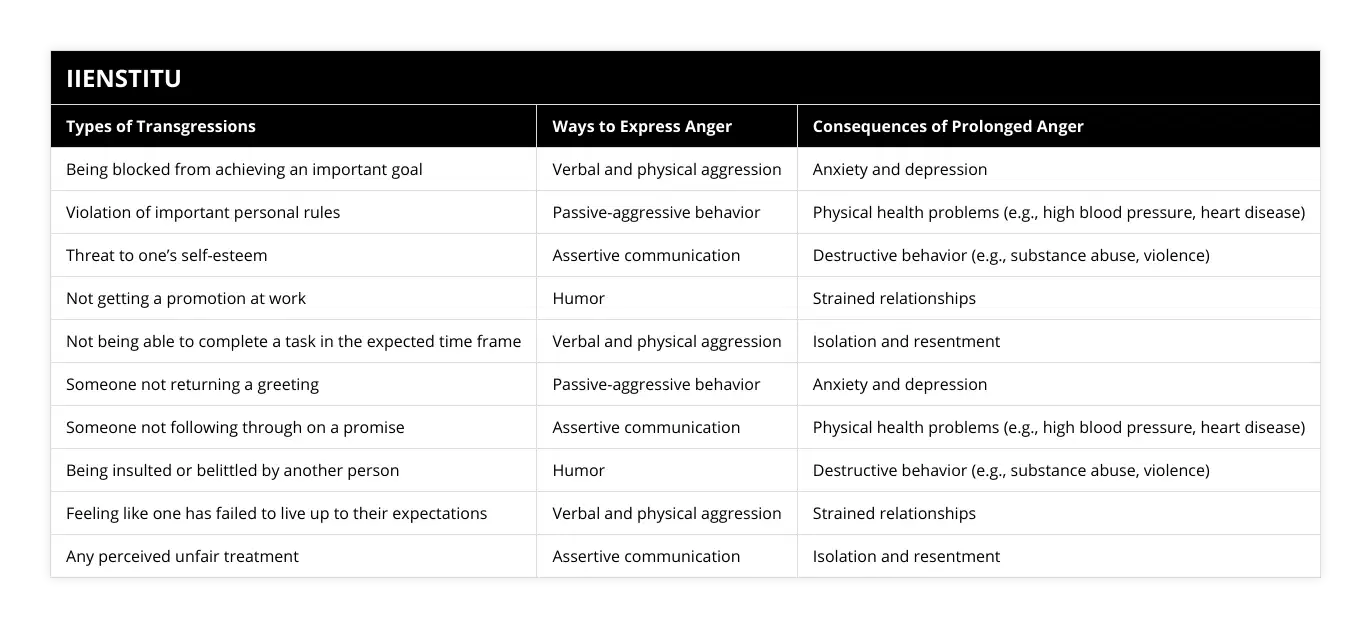
Examples include:
Ignoring someone's calls or messages.
Making sarcastic remarks under your breath.
Procrastinating on tasks to inconvenience others.
Passive-aggressive behavior can be just as harmful as overt aggression, creating confusion and resentment. It undermines trust and can erode relationships over time.
3. Assertive Communication
This is a healthier way to express anger. It involves being honest and direct about your feelings without being aggressive.
Benefits of Assertive Communication:
1- Promotes understanding.
2- Respects both your rights and those of others.
3- Can lead to constructive solutions.
For example, saying, "I felt upset when my idea wasn't acknowledged during the meeting. Can we discuss this?" opens the door to dialogue.
4. Humor
Sometimes, injecting a bit of humor can diffuse tension. But be careful—the humor should not be sarcastic or at someone else's expense. A lighthearted comment can ease the situation, but it requires sensitivity.
Consequences of Prolonged Anger
Now, what happens if we let anger simmer over time?
Mental Health Impacts
Anxiety and Depression: Continuous anger can contribute to feelings of anxiety or lead to depression. When we're constantly on edge, it takes a toll on our mental wellbeing.
Increased Stress Levels: Chronic anger keeps the body in a heightened state of stress, affecting our ability to relax.
Physical Health Problems
High Blood Pressure: Chronic anger can lead to hypertension.
Heart Disease: There's a link between prolonged anger and heart problems.
Weak Immune System: Constant stress from anger can weaken our body's defenses, making us more susceptible to illnesses.
Destructive Behaviors
Prolonged anger might push individuals toward:
Substance Abuse: Using alcohol or drugs to cope.
Risky Behaviors: Engaging in actions that are harmful to oneself or others.
Self-Harm: In extreme cases, unmanaged anger can lead to self-destructive actions.
Strained Relationships
Isolation: Others might distance themselves to avoid confrontations.
Resentment: Friends and family may harbor negative feelings, leading to a breakdown in communication.
Professional Consequences: In the workplace, unmanaged anger can hinder career progression and damage professional relationships.
Managing Anger Effectively
So, how can we better handle anger? Here are some tips to manage anger effectively:
Recognize the Signs
Being self-aware is the first step.
Physical Signs: Increased heartbeat, clenched jaws, tight muscles.
Emotional Signs: Feeling irritable, frustrated, or anxious.
Take a Timeout
Just like we tell kids to take a break, adults can benefit too.
1- Step Away: If possible, remove yourself from the triggering situation.
2- Practice Deep Breathing: Inhale slowly through your nose, exhale through your mouth.
3- Count to Ten: It sounds cliché, but it gives you a moment to cool down.
Practice Relaxation Techniques
Incorporate activities into your routine that promote calmness.
Meditation: Helps center your thoughts.
Yoga: Combines physical postures with breathing exercises.
Progressive Muscle Relaxation: Tensing and relaxing muscle groups in sequence.
Express Yourself Calmly
When ready, communicate your feelings using "I" statements.
Avoid Blame: Focus on how you feel rather than accusing others.
Be Specific: Clearly state what's bothering you.
Example:
Instead of: "You never listen to me!"
Try: "I feel ignored when I'm not heard during our conversations."
Seek Professional Help
If anger feels overwhelming, consider:
Therapy: A counselor or psychologist can provide tools and strategies.
Support Groups: Connecting with others facing similar challenges can be beneficial.
Engage in Physical Activity
Exercise is a great outlet for releasing pent-up anger.
Go for a Run: Cardiovascular activities can reduce stress hormones.
Join a Team Sport: This also fosters social connections.
Practice Martial Arts: Provides discipline and a physical release.
Keep a Journal
Writing down feelings can help process emotions.
Daily Entries: Note situations that trigger anger.
Reflect: Look for patterns or recurring themes.
Develop Problem-Solving Techniques
Sometimes, anger stems from real problems.
Identify Solutions: Instead of focusing on the problem, think about possible remedies.
Set Realistic Expectations: Understand that some things are beyond control.
The Role of Lifestyle in Managing Anger
Believe it or not, our daily habits can influence how we handle anger.
Get Enough Sleep
Lack of sleep can make us more irritable.
Aim for 7-9 hours per night to ensure you're well-rested.
Maintain a Healthy Diet
Avoid Excessive Caffeine and Sugar: These can increase anxiety and agitation.
Eat Balanced Meals: Proper nutrition supports overall mental health.
Limit Alcohol Consumption
While a drink might seem calming, alcohol can lower inhibitions and exacerbate anger.
Cultivate Empathy
Understanding others' perspectives can reduce anger reactions.
Practice Active Listening: Focus fully on the speaker.
Ask Questions: Seek clarity before reacting.
Building Resilience
Developing resilience can help us bounce back from anger-triggering situations more effectively.
Focus on Gratitude
Keep a Gratitude Journal: Write down things you're thankful for each day.
Express Appreciation: Let others know you value them.
Set Personal Goals
Having clear objectives can provide direction and reduce frustration.
Short-Term Goals: Achievable in days or weeks.
Long-Term Goals: Aspirations for the future.
Enhance Social Support Networks
Surrounding ourselves with supportive people can buffer against anger.
Connect with Friends and Family: Regular interactions strengthen bonds.
Join Clubs or Groups: Shared interests foster new friendships.
Conclusion
Anger isn't inherently bad—it's a natural emotion that signals when something is wrong. What's crucial is how we handle it. By understanding our triggers and choosing healthy ways to express anger, we can prevent the negative consequences associated with prolonged irritation.
Remember, mastering anger is like optimizing any process—it requires insight, patience, and practice. Just as we might seek to optimize supply chain management process tips to enhance efficiency, we should strive to refine how we manage our emotions for a healthier, happier life.
At the end of the day, anger is fleeting, but its effects can linger. By learning to control it, we not only find peace within ourselves but also foster better relationships with those around us.
Anger is a fleeting emotion, but its consequences can last a lifetime; learn to control it, and you will find peace.
References
1- Spielberger, C. D. (1999). State-Trait Anger Expression Inventory-2 (Professional Manual). Psychological Assessment Resources.
2- Tavris, C. (1984). Anger: The Misunderstood Emotion. Simon & Schuster.
3- Novaco, R. W. (1975). Anger Control: The Development and Evaluation of an Experimental Treatment. Lexington Books.
4- Ellis, A. (2003). Early Theories and Practices of Rational Emotive Behavior Therapy and How They Have Been Augmented and Revised During the Last Three Decades. Journal of Rational-Emotive & Cognitive-Behavior Therapy.
5- Goleman, D. (1995). Emotional Intelligence: Why It Can Matter More Than IQ. Bantam Books.
6- Smith, T. W., & Mackenzie, J. (2006). Personality and Risk of Physical Illness. Annual Review of Clinical Psychology.
Note: This content is a synthesis of general knowledge on the topic of anger management and includes hypothetical examples for illustrative purposes.
Frequently Asked Questions
What are some effective strategies for managing anger?
Anger is a normal emotion that everyone experiences from time to time. However, it can hurt physical and mental health when it becomes too frequent or intense. Fortunately, several strategies can help to manage anger effectively.
One effective strategy for managing anger is to practice relaxation techniques. For example, taking a deep breath and counting to 10 can help to slow down the body’s response to irritation. Other relaxation techniques, such as visualization, progressive muscle relaxation, and guided imagery, can also be helpful.
Another strategy for managing anger is to communicate effectively. It is important to express feelings assertively and avoid attacking or blaming others; learning to listen to others and to express one’s feelings calmly and respectfully can reduce the intensity of the emotion.
In addition, it is essential to take time out to cool off. Taking a break to go for a walk or do something else can help to reduce the intensity of the emotion. It is also beneficial to engage in activities that can help to reduce stress and relax the body.
Finally, it is essential to consider the triggers of anger. Identifying the situations, people, or thoughts that trigger anger can help to anticipate and manage the emotion. It can also be helpful to practice problem-solving strategies to address the underlying cause of the feeling.
In conclusion, anger can be an intense emotion that can hurt physical and mental health. Fortunately, several strategies can help to manage anger effectively. These strategies include relaxation techniques, effective communication, taking time to cool off, and considering anger triggers. By utilizing these strategies, individuals can better manage their anger and lead happier, healthier lives.

How can I identify the root cause of my anger?
Anger is an emotion that can be difficult to manage, and it is essential to understand the underlying triggers that lead to the feeling. While everyone experiences anger, it is possible to identify the root cause to manage it better. By examining the source of the anger, individuals can work to reduce the impact of their emotions and improve their mental health.
The first step to understanding the cause of anger is identifying the stimuli that trigger the emotion. People may experience irritation in response to various events, ranging from a perceived slight to a traumatic event. It is important to note that the source of the anger may be related to the individual’s past experiences, such as a difficult childhood or emotional trauma. It is also important to note that anger can be triggered by situations that are out of the individual’s control, such as a natural disaster or the death of a loved one.
Once the triggers have been identified, it is essential to examine the individual’s emotional response to the event. Individuals may experience various emotions, from fear to sadness to anger. It is necessary to recognize the other emotions that may be present, as they can provide important insight into the root cause of the offense.
Finally, it is essential to examine the individual’s thought patterns that may lead to anger. For example, individuals may find that they experience a range of negative thoughts, such as blaming themselves for the event or feeling that the situation is hopeless. It is important to note that these thoughts can lead to a cycle of anger and other adverse outcomes.
By understanding the root cause of anger, individuals can work to reduce the impact of the emotion. Identifying the triggers, feelings, and thought patterns that lead to anger can help individuals to manage the emotion better and to improve their mental health. In addition, understanding the source of anger can help individuals to find new ways of responding to the feeling.
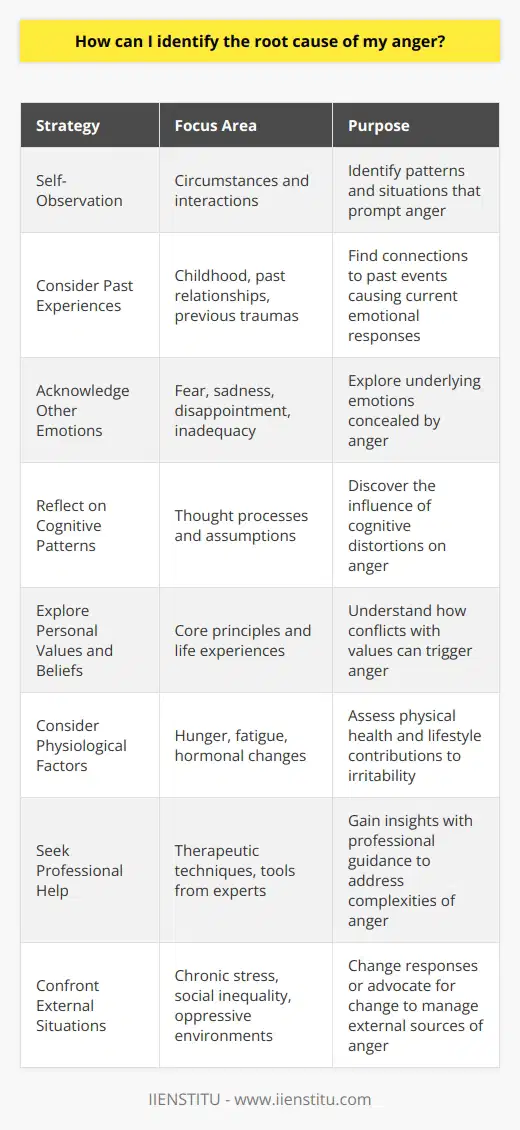
What are the potential consequences of prolonged anger?
The expression of anger is a natural and necessary part of life, but when it is not managed correctly, the consequences can be severe irritation. In addition, prolonged irritation can cause physical, emotional, and social health risks and can even lead to destructive behaviors such as violence.
Physically, anger can increase blood pressure and heart rate, cause muscle tension, and lead to headaches and other physical pain. In extreme cases, it can even increase the risk of a heart attack. Additionally, when anger is left unchecked, it can lead to chronic health conditions such as depression, anxiety, and substance abuse.
Emotionally, prolonged anger can cause a person to become more isolated and distant from loved ones. It can lead to guilt, shame, and low self-esteem and cause feelings of powerlessness and despair. Additionally, it can lead to extreme resentment and bitterness, which can have long-lasting effects on relationships.
Socially, anger can hurt relationships. It can lead to aggressive behavior, damaging relationships, and hurting those around us. It can also cause us to become more isolated, leading to a lack of meaningful connections with others.
When anger is not managed correctly, it can have serious consequences. Therefore, it is essential to understand the potential risks of prolonged irritation and to take steps to manage it. This can include learning to express anger healthily, seeking professional help when necessary, and practicing mindfulness and relaxation techniques. Taking these steps can help us avoid prolonged anger's potentially adverse consequences.
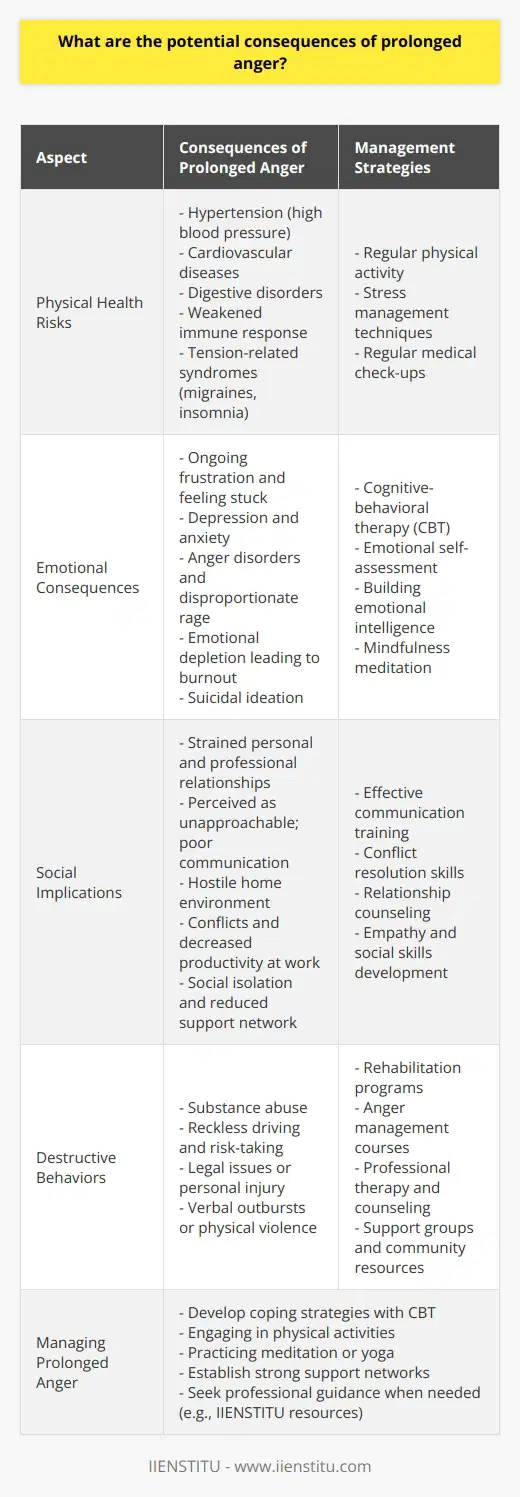
Can a life coach help with overcoming anger issues effectively?
Anger Management and Life Coaching
A life coach can help individuals overcome anger issues effectively by employing various techniques tailored to the person's needs. As part of their professional training, life coaches possess the skills necessary to identify the underlying causes of anger and develop strategies to address them.
Root Causes of Anger
Identifying the root causes of anger is a vital step in the process of managing anger. In many cases, anger is a manifestation of underlying emotions or unresolved conflicts that may be causing distress in an individual's life. A life coach can work with their clients in recognizing these triggers and help them confront these issues in a healthy manner.
Coping Mechanisms and Techniques
Once the root causes of anger have been identified, a life coach can provide clients with coping mechanisms and techniques that can alleviate or eliminate anger's intensity. These techniques may include mindfulness exercises, relaxation techniques, communication improvements, or cognitive restructuring therapy. Providing an array of methods allows the individual to choose the most suitable and comfortable technique for them, leading to more effective anger management.
Creating a Supportive Environment
Another crucial aspect of overcoming anger issues is the cultivation of a supportive environment. A life coach can help individuals establish a safe, non-judgmental space where they can express their feelings and emotions openly and honestly. The life coach also serves as an objective sounding board, which promotes self-reflection and growth. This supportive environment fosters a sense of trust between the life coach and client, allowing the individual to feel more understood and less alone in their anger.
Setting Achievable Goals
To facilitate success in anger management, a life coach guides clients in establishing achievable goals that will contribute to their emotional well-being. By creating a roadmap toward emotional growth, the individual gains a sense of purpose and direction in overcoming their anger issues. The life coach assists the client in monitoring their progress and providing feedback along the way. This support and encouragement can inspire clients to remain persistent in their pursuit of emotional growth.
In conclusion, a life coach can play a vital role in helping clients address their anger issues effectively. By identifying the root causes of anger, teaching coping mechanisms, creating a supportive environment, and setting achievable goals, life coaches empower their clients to overcome their challenges and improve their overall emotional well-being. Over time, this process can lead to a significant reduction in anger's intensity and frequency, contributing to a more balanced and harmonious life.
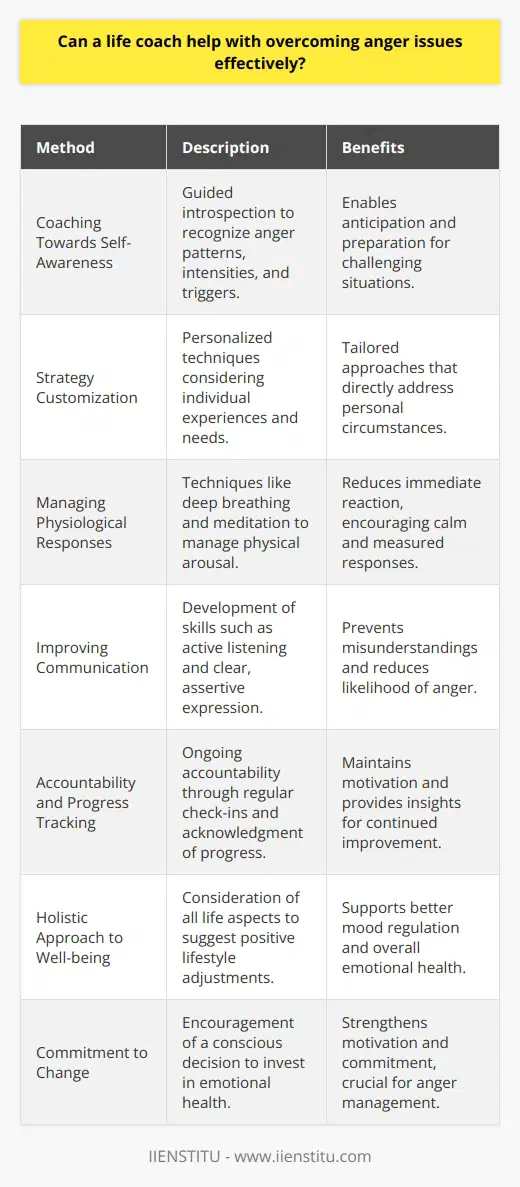
What techniques are frequently used in coaching someone with anger-related challenges?
Cognitive-Behavioral Techniques
For individuals experiencing anger-related challenges, cognitive-behavioral techniques are often employed by coaches. These methods involve identifying and modifying negative thought patterns that contribute to anger. By helping clients recognize the irrationality of their thoughts, coaches can guide them towards replacing these unproductive ideas with healthier, more constructive alternatives.
Relaxation Techniques
Another frequently used approach in anger management coaching is teaching relaxation techniques. Deep breathing exercises, progressive muscle relaxation, and visualization practices can aid clients in calming their physiological responses to anger-inducing situations. These tools enable individuals to exert control over their emotions, preventing escalation into destructive actions.
Communication Skills Training
Effective communication plays a vital role in managing anger. Coaches often provide clients with instruction on assertiveness techniques and active listening strategies. The ability to express oneself respectfully and understand others' perspectives reduces the likelihood of misunderstandings and conflicts, allowing for a more proactive response to emotional triggers.
Problem-Solving Skills
Developing problem-solving skills is a crucial aspect of anger management coaching. Clients are taught to analyze the circumstances leading to anger and identify potential solutions to resolve the situation. This approach encourages rational decision-making, reducing impulsive reactions driven by negative emotions.
Emotional Intelligence Training
Coaches may also focus on enhancing clients' emotional intelligence, helping them become more attuned to their own emotions and those of others. By increasing self-awareness and fostering empathy, individuals can better anticipate potential anger triggers and respond to them in a more balanced and measured way.
Social Support
In some cases, coaches may also encourage clients to seek social support from friends, family, or group therapy sessions. Sharing experiences, challenges, and coping strategies with others facing similar difficulties can provide valuable insights and bolster the individual's morale through shared understanding and encouragement.
In conclusion, a variety of coaching techniques are available to assist individuals in managing anger-related challenges. Approaches such as cognitive-behavioral techniques, relaxation exercises, communication skills training, problem-solving guidance, emotional intelligence development, and social support can all contribute to helping clients gain control over their emotions and improve interpersonal relationships.

How can one integrate the top 10 anger management strategies into daily life?
Identifying Triggers
To integrate the top 10 anger management strategies into daily life, one must initially identify the factors that provoke negative emotions. By recognizing triggers, an individual can anticipate and subsequently manage their reactions more effectively.
Practicing Deep Breathing
Integrating deep breathing exercises into daily routines, such as during stressful situations or simply after waking up, can help regulate emotional responses and mitigate the effects of anger.
Exercise and Physical Activity
Incorporating exercise and physical activities into one's everyday schedule, such as walking or yoga, contributes to improved mood regulation by releasing endorphins that naturally help alleviate stress and anger.
Developing Empathy
Actively working on developing empathy for others, by understanding different perspectives and placing oneself in another's shoes, can lead to less anger and frustration in daily interactions with others.
Improving Communication Skills
Enhancing communication skills, which includes expressing feelings assertively yet respectfully, can greatly reduce misunderstandings that might otherwise lead to anger and conflict.
Utilizing Relaxation Techniques
Incorporating relaxation techniques, such as progressive muscle relaxation or meditation, into one's daily routine is crucial for managing anger effectively. These methods promote a more relaxed state and decrease emotional intensity.
Setting Healthy Boundaries
Establishing healthy personal boundaries enables individuals to protect themselves from negative influences that may provoke anger, while still maintaining positive relationships with others.
Seeking Support
Creating a support system, either by connecting with friends or family or by joining an established anger management group, can provide valuable insights and enable individuals to better navigate feelings of anger in their daily life.
Developing Problem-Solving Skills
Cultivating problem-solving skills is essential for managing anger, as it equips individuals with the ability to identify solutions to issues that contribute to their emotional distress.
Implementing Time-out Techniques
Practicing brief time-out periods during moments of heightened anger enables individuals to regain control of their emotions and approach situations with a sense of calm. Incorporating these strategies into daily life ultimately promotes a balanced emotional state and fosters long-lasting anger management.
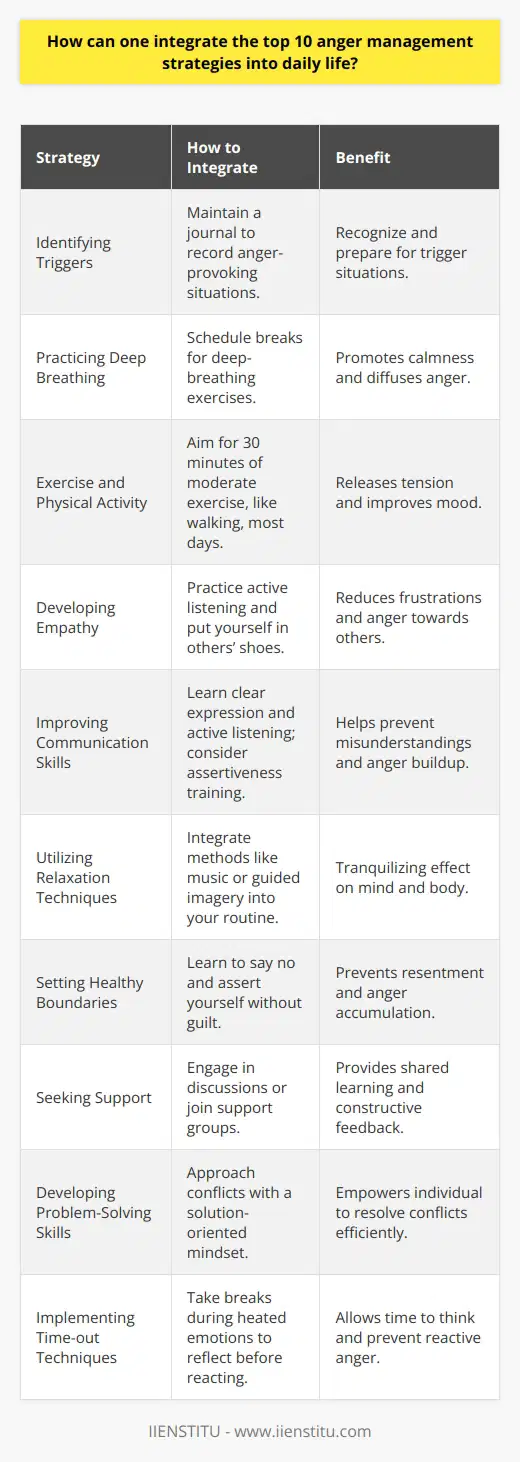
What is the 5 step approach to managing anger?
Understanding the Five-Step Approach to Managing Anger
Step One: Acknowledge the Anger
The first step in managing anger involves acknowledging its presence. It is essential to accept anger as a natural and valid emotion. Identifying the triggers causing the anger is a crucial part of this step.
Step Two: Develop Self-Awareness
Next, individuals should develop self-awareness. Understanding one's physical reaction to anger, such as increased heart rate or tension, helps in recognizing when one is getting angry.
Step Three: Implement Relaxation Techniques
The third step involves utilizing relaxation techniques. These can include deep breathing, progressive muscle relaxation, or practicing mindfulness. These techniques help to lower the physical responses to anger and bring about calming effects.
Step Four: Employ Problem-Solving Skills
In the fourth step, individuals should focus on utilizing problem-solving skills. Identifying the root cause of the anger and devising possible solutions helps in managing emotional responses. Taking a break, if necessary, can allow for clearer thinking during this step.
Step Five: Practice Positive Self-Talk
Finally, the last step encourages positive self-talk. Reframing negative thoughts and reminding oneself of the ability to handle upsetting situations effectively can further manage the anger.
Implementing these five steps can provide a structured approach to managing anger. It promotes self-awareness, self-control, problem-solving, and effective communication, which are necessary for maintaining positive emotional health. Regular practice of these steps can assist in preventing heightened emotional responses and lead to a healthier management of anger.
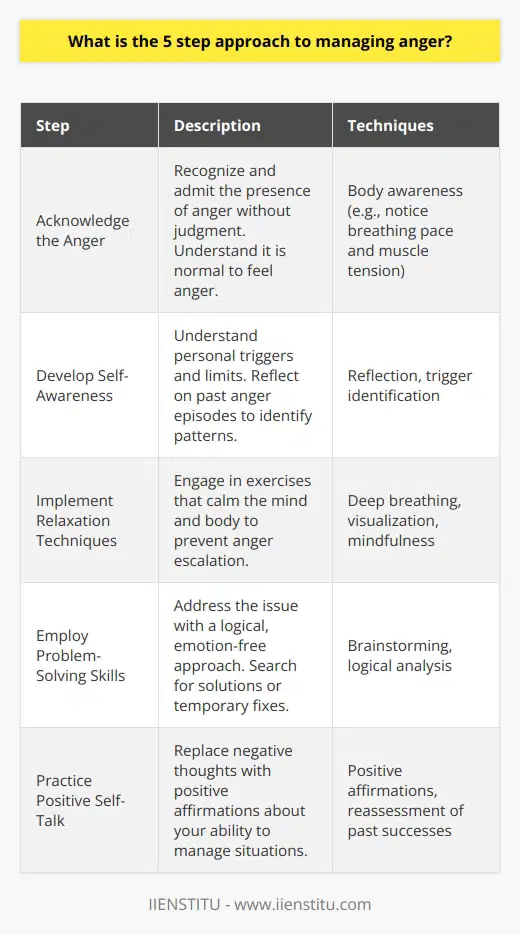
What are the 3 anger rules to help maintain self-control during emotionally charged situations?
Understanding Anger Rules
To maintain self-control in emotionally charged situations, it's necessary to follow three essential anger rules.
Rule 1: Acknowledge Anger
The first rule requires recognizing and acknowledging anger. Simply repressing anger can lead to uncontrolled outbreaks later on. Acknowledging anger doesn't mean we have to act on it.
Rule 2: Self-Regulation
The second rule underlines the importance of self-regulation. This involves drawing upon techniques like deep-breathing exercises, mindfulness, or cognitive-behavioral strategies like thought-stopping, which can help prevent an escalation into reactive anger.
Rule 3: Positive Expression of Anger
The third rule involves expressing anger positively. It's inevitable to feel anger, but communication is key to express it without resorting to aggression. Using 'I' statements instead of 'you' statements, helps talk about our feelings, avoiding blame or criticism.
These three anger rules offer a beneficial framework for understanding our emotional responses and promote effective strategies for managing anger during hostile circumstances. By following these rules, one can maintain self-control and handle emotionally charged situations more effectively.
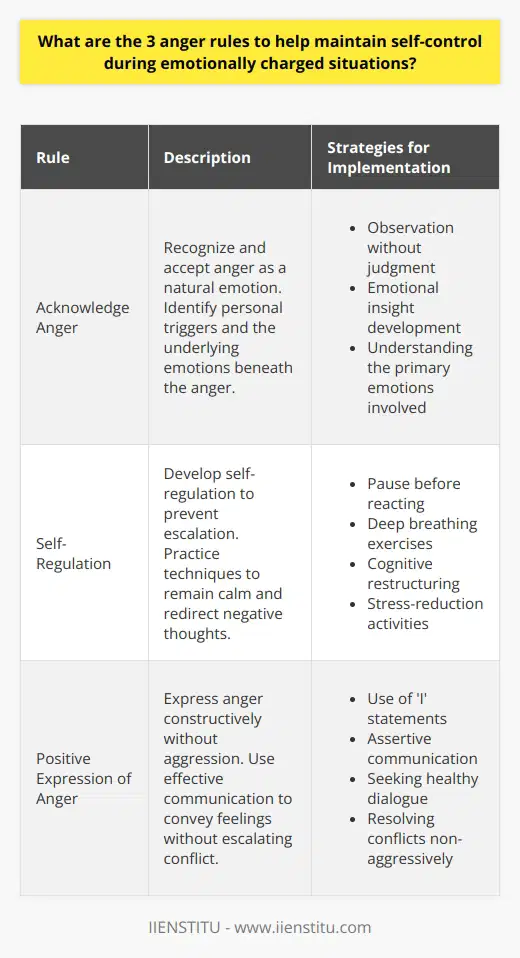
What are 7 good ways to help deal with anger in order to promote healthier communication and relationships?
Understanding and Expressing Feelings
Firstly, understanding and properly expressing feelings can play a central role in managing anger. When we are aware of our feelings, we can choose a healthier response rather than reacting impulsively.
Physical Activity
Secondly, regular physical activity helps to reduce stress, thus lessening feelings of anger. Engaging in exercises or sports can act as a natural outlet for pent-up emotions.
Mindfulness and Meditation
Practising mindfulness or meditation can also be instrumental in managing anger. Allowing oneself the space to process and acknowledge emotions can result in reduced hostility.
Positive Affirmations
Positive affirmations are another effective method of controlling anger. Positive self-talk encourages healthier thought patterns and can help in pacifying tumultuous emotions.
Anger Management Techniques
Implementing anger management techniques, such as counting to ten or deep breathing, can provide an immediate relief from an angry outburst. These strategies allow a moment for reflexion and help avoid irrational reactions.
Unwinding Activities
Engaging regularly in hobbies or activities that provide enjoyment and relaxation can prevent feelings of anger from escalating. These unwinding activities help in creating a harmony between mind, body, and emotion that consequentially lowers anger.
Professional Support
Finally, seeking professional assistance, like therapy or counselling, can be highly effective. The guidance of a trained professional often helps in formulating personalized strategies for anger management. With the right support, one can find ways to express anger constructively, leading to healthier communication and improved relationships.
Thus, properly dealing with anger can enhance communication and foster healthier relationships. It is essential to remember that anger is a natural emotion that requires understanding and control, rather than repression.
